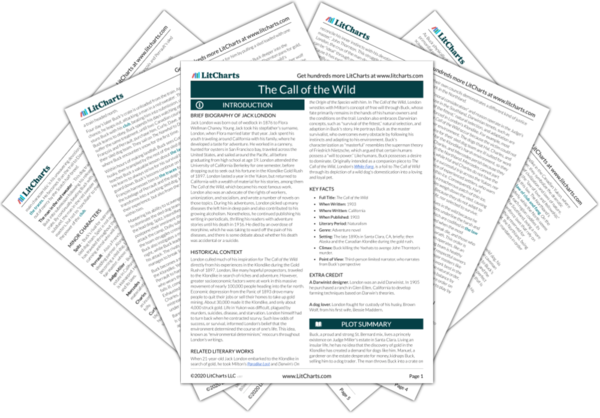Summary
Analysis
The sled dog team arrives at Skaguay thirty days later. The dogs are weary, so when the Scotsman is called to make another delivery, he replaces them with new dogs, selling Buck and his team to Hal and Charles, a family of amateur settlers, who are "out of place" in the Northland.
Buck changes hands again, signaling a shift in his relationship with man. London's note that Hal and Charles are "out of place" suggests that they are not fit to survive in the Klondike because of their inexperience and other attributes.
Themes
The dogs are taken to camp, where Hal's sister and Charles' wife, Mercedes loads up the sled with pots, pans, clothes, and tents. The sled is so heavy that the dogs cannot pull it. Though town's folk warn against carrying such weight, Hal proceeds, attempting to spur the dogs forward with his whip. Mercedes pleads with the dogs to run. One onlooker recommends that they break their sled's runners out of the ice. This works, but when the sled slides down a steep slope half the load tumbles off into the snow. Buck leads his team onward, running away from the scene.
Hal, Charles, and Mercedes' are poor masters because they are foolish and inconsiderate. They don't listen to experienced settlers (i.e. they don't learn) and are violent toward their dogs. Unlike Franois, Hal is not judicious in using his whip; he uses it to resolve any problem, even if it is not the most effective solution. His propensity towards violence suggests that he will be a cruel master.
Themes
Kind-hearted towns folk collect the dogs and fallen articles, but also advise Hal, Charles and Mercedes to lighten their load and acquire more dogs. They cut the load in half and buy six dogs, creating a massive team of fourteen hounds. Yet the load remains heavy, while the new dogs, a miscellaneous group of luxury breeds and "mongrels," called the "Outsides" are quite inexperienced for the trail ahead.
Hal, Charles, and Mercedes' difficulty in assembling their sled demonstrates their unwillingness to adapt. That they buy more dogs and barely lighten their load shows that they would rather impose their material possessions onto the land, than adapt to it. Given that they themselves are ill suited to the Northland, it is unsurprising that they foolishly acquire dogs that are also unsuited and inexperienced.
Themes
Buck distrusts his new owners, observing that they are undisciplined, disorderly, and unable to "learn." Because Hal miscalculates their rations, they run out of dog food. Underfed, the team's run time slows and stamina dwindles. The Outsides perish quickly, while the remaining dogs starve. Hal, Charles, and Mercedes, constantly squabble, making them "callous" to the suffering of their animals.
Hal, Charles, and Mercedes' lazy, inconsiderate nature makes them not only poor masters, but poor learners. They quarrel, instead of tending to their animals, showing that they are incapable of sympathy, or learning new skills. Because they don't adapt, their dogs suffer, and so do they.
Themes
Get the entire The Call of the Wild LitChart as a printable PDF.

Hal's whip and club drive Buck and his team onward, despite their exhaustion. Only five dogs remain, after Hal kills Billee with an ax for falling down in the traces. Wounded, weary, and traumatized, the dogs do not even notice that spring has arrived. The ice and snow is starting to melt as they arrive at John Thornton's camp at the mouth of White River.
Hal rules like a slave master. He fails to feed his dogs and then whips, clubs, and kills them when they fail. His behavior is unjust and a perversion of the necessary relationship between man and dog, in which man cares for his dogs so the dogs can help him.
Themes
Literary Devices
The dogs drop down in exhaustion at John Thornton's camp. Thornton advises Hal not to cross the river, because the ice is thinning. Hal disregards this warning, instead whipping his dogs to get up and run. Yet Buck, overcome by an "impending" sense of "doom," refuses to rise. Hal takes up his club and beats Buck. Just as life is about to flicker out of him, Thornton tackles Hal, rescuing Buck from the brink of death. Hal threatens Thornton with his knife, but Thornton knocks it out of Hal's hands with his ax. Thornton picks up the knife, using it to cut Buck out of his traces. Hal, tired from the fight, retreats with Charles, Mercedes and the remaining dogs, heading towards the riverbank. Thornton and Buck watch the distant sled as it suddenly drops through the ice into a "yawning hole."
Hal, Charles, and Mercedes ultimately perish because they flagrantly disrespect nature. They refuse to relinquish their possessions, they ignore the warnings of melting ice, and Hal nearly kills Buck. That they fall through ice underlines their folly, as well as nature's wrath. Buck avoids this fate because he follows his intuition, emphasizing that his feral senses are strong. Buck's survival, juxtaposed against Hal's death, also proves that not all masters are worthy of wielding the club—and that those who aren't worthy will eventually lose their power, as Hal does. Meanwhile, Thornton's brave rescue of Buck shows that he is worthy to take up ownership of Buck.
Themes












